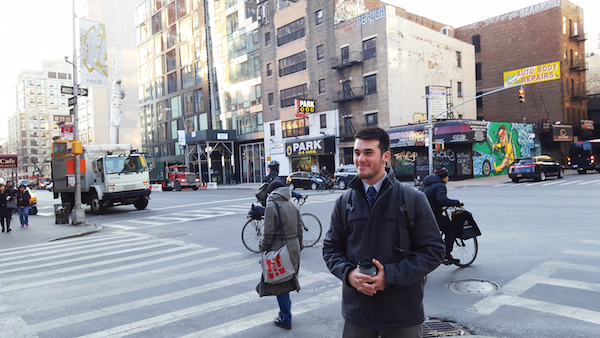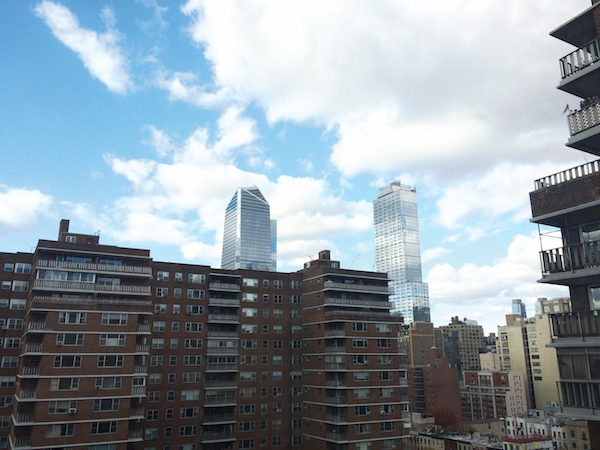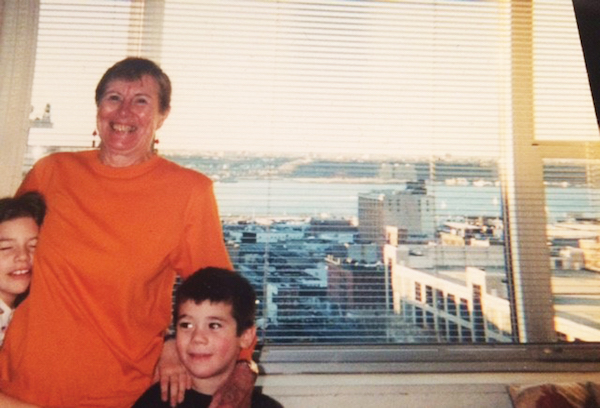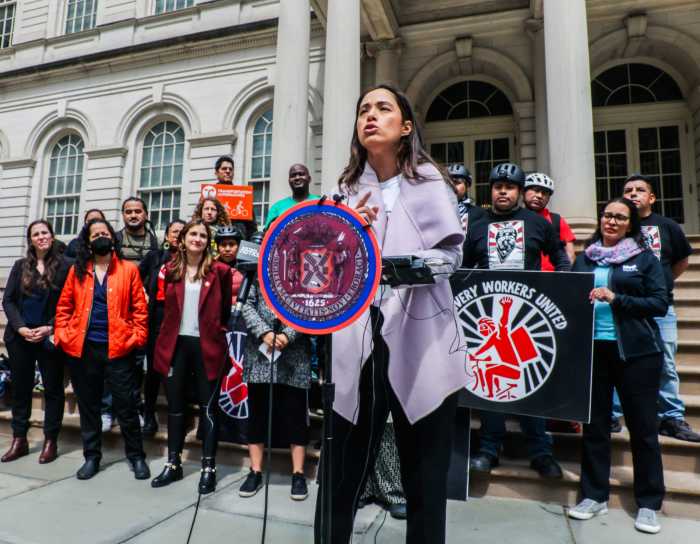
BY DUSICA SUE MALESEVIC | Wyatt Frank, a longtime Penn South resident, can survey the playground he went to as a child, where his grandfather used to play squash, and also see glitzy new buildings with monthly rents —$27,000 — that are more than what some people make in a year.
Frank recently took a “gentrification walk” with Chelsea Now after spending two and a half months researching, collating data, and creating “Chelsea Living” — a website that looks at development in the neighborhood starting with the “affordable housing havens” — Penn South, the Robert Fulton and Chelsea-Elliot Houses — of the 1960s.
The 21-year-old’s maternal grandparents — Emily and Newton Greenberg — had lived in Chelsea since the 1950s, he said, and moved into the co-op when it opened in 1962. His grandparents, being part of the co-op, helped to get his mom an apartment in the complex, and he grew up there with his parents, Elizabeth and Cory Frank, and his sister Sabrina.
“Chelsea Living” (chelsealiving.weebly.com) was spurred by a required capstone project to earn his bachelor’s degree in American Culture at the University of Michigan.
“I realized in that time that I wanted to just devote the next — this was around two and a half months — to figuring out what was happening in Chelsea in terms of housing,” Frank explained at Bean & Bean Coffee (318 Eighth Ave., at W. 26th St.) before the walk. “It seemed like such a hot topic issue right now, such a buzzword — ‘affordable housing.’ ”
Frank was taken aback when he went to Michigan, and people immediately knew about his neighborhood, and attractions such as the High Line, he said.
“I’m not that old, but I remember being younger and the neighborhood being different,” he said, noting that it wasn’t the tourist destination it is now. “And so I realized that the neighborhood had been changing — it looked more shiny now and glass-built. So I knew that, but it hadn’t hit me, I guess, the larger bigger picture of it.”
Frank also interned at City Councilmember Corey Johnson’s office during the summers of 2014 and 2015, and heard constituents talking about affordable housing and development.
“It means a lot to people,” he said. “I had never totally recognized the significance of the co-op until I talked to people and realized that it’s kind of different — there’s a total life outside of having the opportunity to live in a co-op.”
After looking for data through websites, such as Social Explorer, Frank started to build a picture of development in Chelsea throughout different decades, and looked at demographic shifts as well. He also focused on major policies that could constrain or spark development.
Time periods are broken down by section on chelsealiving.weebly.com, so one learns about the tax break 421a, Section 8 housing, and Mayor Ed Koch’s housing plan of 1985 in the 1970 to 1990 part. In the 1990 to 2005 section, Frank highlights the City Council’s 1994 vacancy decontrol law, a 1996 contextual zoning proposal by Community Board 4 (CB4), Mayor Michael Bloomberg’s New Housing Marketplace Plan of 2003, and the rezoning of West Chelsea are tackled.
From the part that covers 2005 to the present, the effect of the High Line on real estate prices is explored, as well as a look at Mayor Bill de Blasio’s affordable housing plan.
Frank said the website was created to educate himself on the complicated issue that is housing.
“I wanted to be a resource for my neighbors, because people have a lot of things to say about housing and I learned that it’s really hard to find this information,” he said.
Penn South neighbors have been providing Frank with feedback on “Chelsea Living,” with an acquaintance of his mom calling, and giving him compliments and some pointers for the site, he said.
“People, I think, appreciate that there is a website where they can find information and at least use it as a starting point for conversation, to use as a reference,” Frank said.
He said it was nice to find that one of the major proposals was CB4’s 1996 contextual zoning plan, which he called “totally grassroots and community driven,” and realizing that Penn South is a large NORC (naturally occurring retirement community).

The roles of the community, councilmember and community board are important, and Frank said that development of a neighborhood should go through the community.
“I think those primary stakeholders that are the people who live here should have the first word in how development is undertaken,” he said.
Frank said that he was also struck by how expensive some of the new units were. Using information from StreetEasy.com, Frank highlighted buildings on the site, such as 505 W. 19th St., where the average monthly rental is $17,708, and 200 11th Ave., which has an average rental of over $27,000.
Frank said he plans on updating the website. He will be working on Johnson’s upcoming reelection campaign, and is also considering pursuing a law degree.
“Chelsea Living” has added a new layer of perspective to where Frank grew up.
“I’m really grateful that I grew up there and have the community that I do,” he said. “Penn South is really involved, I think, in voicing their opinions in local politics — I do really appreciate that as well.”







































